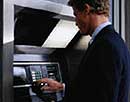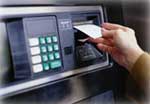|
 Hyderabad: Many banks in India, both private and public, are planning to increase their network of ATMs (automated teller machines). ICICI Bank and State Bank of India (SBI) have a large network of ATMs across India. Hyderabad: Many banks in India, both private and public, are planning to increase their network of ATMs (automated teller machines). ICICI Bank and State Bank of India (SBI) have a large network of ATMs across India.
And SBI recently announced that it is going to install 1,500 ATMs in the coming months, in addition to the existing base of around 1,500 ATMs. But the question is whether these new ATMs are cost effective. Let we check the cost incurred by a bank to install an ATM and the number of transactions required for an ATM to break even. First, to install an ATM, a bank has to incur the cost of the ATM and its installation expenses. In addition to the fixed expenses incurred by a bank there are the recurring costs like operating expenses, maintenance and security. To recover these expenses the minimum balance per ATM card required is around Rs 5,000 - this amount, of course, is too high for a common man. Alternatively, the bank should increase the number of customers and the volume per withdrawal.  Secondly, to break even, around 250 transactions are required per machine. But many ATMs have, on an average, less than 100 transactions per day; in some cases it is even around 50. Due to these impediments many bank are making loss on some of the ATMs. Secondly, to break even, around 250 transactions are required per machine. But many ATMs have, on an average, less than 100 transactions per day; in some cases it is even around 50. Due to these impediments many bank are making loss on some of the ATMs.
Though the banks know that they will incur a loss by installing a new machine at a place where business is bleak, they continue to add new machines to their network. The reason is simple: the banks want to improve their image in a competitive market, and also want to ensure a full range of facilities to their customers. There are some ways by which banks can reduce their cost on ATMs and break even on them. Sample some:
- Instead of expanding the network by installing more and more ATMs, sharing an ATM network is a better alternative for banks to reduce the huge cost incurred by the same. In addition to the reduction in cost it will also provide a bigger network to customers across the country. For example, Bank A has is concentrated in the northern part of the country and Bank B has its major presence in the southern part, and both have around 500 ATMs each. If Bank A wants to provide more ATMs to their customers in the south and Bank B in the north, they might have to install more ATMs. But if Bank A and B collaborate, then Bank A customer can access all the, say, 500 ATMs of Bank B in the south. Similarly Bank B customers can access all ATMs of Bank A in the north. This way, the customers of Bank A and B can access a total of 1,000 ATMs, instead of 500. And the two banks will save the new ATM, installation and operating costs and provide a better network to their respective customers.

- This is a luring opportunity to many private and public sector banks and if they form a cluster, an optimal use of ATMs can be made. Recently, some banks have started a cluster to provide a larger network of ATMs to their customers in which Punjab National Bank is the lead bank. The other banks are UTI Bank, Global Trust Bank, Andhra Bank, Oriental Bank of Commerce and Vijaya Bank. Two more banks plan to join the cluster in the near future.
- During the peak hours, at frequently used ATMs, there are long queues and sometimes one has to wait for 20-25 minutes, which is against the very purpose of installing an ATM. This can be tackled by educating the customers about the use of the machine, which helps in reducing the time consumed by a customer to complete a transaction. Thus a machine can handle more transactions per day.
- Banks install ATMs offsite and onsite. The major factors that encourage the banks for installing an ATM offsite are convenience, speed and proximity to the point of use by the customers. Since ATMs are most useful only after the office hours, appropriate locations for the ATMs are near petrol pumps, telephone booths, hotels and hospitals. Also appropriate is to open ATMs at the centre of the town or at places where people assemble every day.
Pahuja is a member of the editorial team of Professional Banker, a magazine for bankers.
|